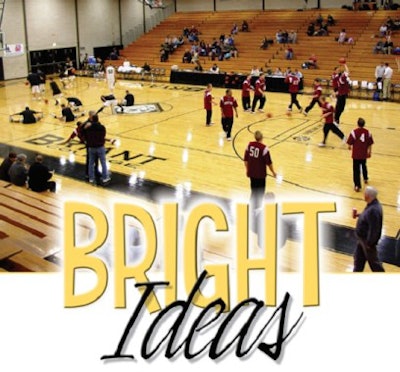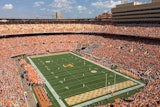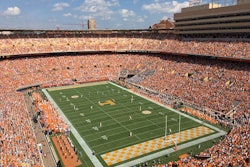Light bulbs popping up over courts and corridors couple familiar looks with newfound efficiencies

Basketball players take the floor within the intense beam of a spotlight and to the equally intense beat of the Baha Men's "Who Let the Dogs Out." The more appropriate question for fans who find themselves in the dark - literally and figuratively - might be, "Who turned out the lights."
This is Division II Bryant College in Smithfield, R.I., where the Bulldogs are lucky to draw a few hundred fans to their home games. But that doesn't stop the school from jazzing up player introductions with a bit of Madison Square Garden flair. Specifically, it's the light bulbs above the Bryant Athletic & Recreation Center court that keep the pregame show rolling. They are compact fluorescent bulbs, which unlike their metal halide predecessors can be turned back on instantly once they are turned off. Had such fanfare been attempted in the past, tipoff would have been set back a full 15 minutes as the metal halides sufficiently cooled for a restrike.
"The announcer hits the button, all the lights in the room go off and the kids go crazy," says Bill Gilmore, the college's facilities engineer and the self-proclaimed world's biggest advocate of fluorescent technology for indoor sports applications. "It's just one more thing that people didn't think we could do with lighting. Now lighting has become an important part of the game."
Today's lighting game has taken on greater importance, too, amid escalating energy costs and shrinking institutional budgets. It's a game with an evolving roster of players, each with strengths and weaknesses. For years, when choosing suitable lamps to illuminate their courts, corridors, control desks and closets, facility operators like Gilmore have juggled such issues as each lamp's cost, lifespan, output, efficiency and ease of maintenance. Meanwhile, technology has progressed on a number of fronts over the past 30 years to the point where quality lighting options are at an all-time high.
In some respects, indoor sports lighting has come full circle. Linear fluorescent lamps, the long tubes that quite likely are allowing you to read this page at your office desk, were commonly found in gymnasium ceilings during the 1970s. By today's standards, they were an inefficient lighting solution with a short life and poor color rendering, meaning their blue-hued output tended to drain the skin tone out of anyone who played, no matter how vigorously, underneath them. Then came less-expensive, longer-lasting HID (high-intensity discharge) alternatives, most notably mercury vapor and metal halide, and to a far lesser extent high-pressure sodium. Mercury vapor lamps functioned much like the old fluorescents, but with several 400-watt lamps replacing nearly a full ceiling's worth of tubes. And they seemingly never died; they just faded away in terms of their lumen output. That shortcoming in particular led facility managers to make way for more stable and efficient metal halide lamps, which also represented an improvement over mercury vapor in terms of color rendering.
Meanwhile, fluorescent tubes began mounting a comeback. In recent years they have become more efficient, longer lasting and progressively thinner - from the T12's inch-and-a-half diameter to the 1-inch T8 to the state-of-the-art T5 (the number refers to eighths of an inch). The phosphorous powder that coats the bulb's inner walls (and reacts to ultraviolet radiation emitted by minute amounts of vaporized mercury, thus providing the light that we see) has also improved, bringing fluorescent color rendering nearly on par with the benchmark bulb of warm-toned lighting - the incandescent. These phosphors, which were patterned after those found in the same incandescent lamps that illuminate most homes, dropped the fluorescents' color temperature, or the appearance of the lit bulb when you look directly at it, from the bluish heights of 4,000 degrees Kelvin closer to the reddish incandescent level of 2,700 degrees Kelvin.
Compact fluorescent lamps - which unlike their linear counterparts take on a number of shapes, from spirals to triple tubes, anchored most commonly in commercial and institutional settings by a plugin base - have gained a stronghold in once incandescent-dominated fixtures such as recessed lighting cans and wall sconces. It's no wonder. A $5 compact fluorescent, which produces the same amount of light as a 40-cent incandescent while consuming one-fourth the wattage, will burn nonstop for about 500 days. An incandescent bulb will likely burn out at 40 days. "They cost more to buy, but it pays back so quickly, it's foolish not to consider it," says Rick Barton, senior applications specialist at General Electric, the nation's oldest lighting manufacturer.
"There are three numbers that we equate with lighting," says Steve Goldmacher, director of communications at rival manufacturer Philips. "The bulbs themselves are about 3 percent of the total cost, their maintenance is about 11 percent, and the electricity to run them is about 86 percent. That's the general formula for almost any bulb. If you look at total cost of ownership, some bulbs all of a sudden look better than others."
Moreover, the three major bulb manufacturers - Philips, General Electric and Osram Sylvania - have within the past 10 years succeeded in greatly reducing the amount of mercury in fluorescent bulbs, from more than 22 milligrams per tube to, in the case of Philips, less than 4 milligrams. This has allowed fluorescent lamps that have reached the end of their life to be disposed of without contracting with hazardous materials specialists at fees that make throwing out an old bulb nearly as costly as buying the new one to replace it.
All of this has been enough to make incandescent bulbs all but obsolete in institutional and commercial settings, and if it weren't for recent technological advancements in metal halide lamps, they might have been next. "Improvements in fluorescent technology now make fluorescent the better choice," says Jim Rogers, an independent energy consultant in Chelmsford, Mass., who boasts hands-on experience spanning both fluorescent-to-metal halide and metal halide-to-fluorescent gymnasium conversions. "It has kind of leapfrogged."
Some 425 miles down the eastern seaboard from Bryant College, the 208 member schools of the Fairfax County (Va.) School District are taking a closer look at what fluorescent lamps have to offer. Fourteen of the district's schools are already seeing the light, with conversions from metal halide to T5 fluorescent taking place in gymnasiums (several schools have more than one), libraries and cafeterias. Hallways, offices and classrooms, meanwhile, are being retrofitted with the T8. A second group of 27 schools is now poised for conversion, and so it will go possibly for the next three years at a potential cost (if every successive group follows the lead) approaching $80 million, according to Scott Emerton, energy engineer for Noresco, a Westborough, Mass.-based energy savings company that is also auditing each school's boilers, chillers and windows.
Noresco presents school administrators with lighting schematics that take into account mounting heights (the T5 is too intense at heights lower than 20 feet, Emerton says), adaptability of existing fixtures (the metric-based T5 is too short for any existing linear fluorescent fixture but its own), and the reflectivity of ceilings, walls and floors. In some cases, fixtures were added to gymnasium layouts in order to lift foot-candle readings to levels recommended by the Illuminating Engineering Society - a range of 30 foot-candles, usually for recreational activity, to 120 footcandles for televised events. In cases where the number of fixtures remained the same, the potential savings are clear. "Normally, schools use a standard metal halide lamp and ballast, which together account for 455 watts of energy consumption," Emerton says. "If we're designing for 50 foot-candles in their gymnasiums, the retrofit is generally a one-for-one swap with 234 watts on the fluorescent fixtures." According to Rogers, light bulb conversions that cut a facility's energy consumption in half are common.
Of course, such dramatic savings are only realized when the lights are on. Even greater gains come when they're off. "We also went a step further by putting them on occupancy sensors," Emerton continues. "With the metal halides, you don't have the instant-on capability. With the T5s, you can put them on an occupancy sensor, turn them on and off, and get additional savings when there's nobody in the gymnasium."
"One of the first gymnasium projects I worked on, I found that because these HID lights are not instant-on, they were turned on at 6 in the morning and they stayed on until 10 at night, seven days a week, whether anyone was there or not," adds Rogers.
Facility use is an important consideration when choosing a suitable lighting solution. Like most college facilities its size, Bryant's Athletic & Recreation Center sees more pickup basketball than varsity games. It occasionally welcomes guest speakers and annually hosts convocation ceremonies. Each scenario may require a different light level to meet event requirements. According to Gilmore, compact fluorescent bulbs - which number two to a ballast, eight to a fixture - offer him the flexibility to alter light levels appropriately. "All of these fixtures are switchable," he says. "That means if I have an event where I only need 25 percent of the lights on, I can put 25 percent of the lights on. If I have a cleaning crew going in there to clean up after a game, I can put 50 percent of the lights on for cleaning - and that's more than enough."
In addition, Gilmore can control the light levels produced by individual rows of fixtures. "When we have a basketball game, we want 100 percent of the lights over center court on, but we don't want that much light in the stands. We drop the stands down to 50 percent. Why do we do that? The human eye, by nature, is directed toward the brightest light - in this case, center court. It's just one more example of flexibility," he says.
According to Mike Owens, senior project manager for outdoor and sports products at GE, even lamp failure manifests advantages in the multi-bulb fluorescent fixture. "You lose one bulb out of eight, who cares? But if you lose an HID, there's only one lamp in the fixture. When it burns out, you probably want to do maintenance, because now you've got a hole in your lighting levels."
Here's the bottom-line reason Gilmore does what he does. The Bryant College conversion, which in September 1999 was the first of its kind on any campus on the East Coast, has the potential to draw slightly more energy than ever (the number of active fixtures increased from 18 to 84). However, Gilmore, who sits on his local utility's demand-side management executive board, earned the college $22,000 in utility rebates and $11,000 in annual energy savings by tailoring his light levels to the events at hand. "I actually put kilowatt-hour meters on every row of lights, so I know when a row of lights is on and how many hours that row of lights is on," he says, adding that the aforementioned dollar figures combined to pay for the conversion materials (installation was handled by one in-house electrician) within a year of the changeover.
The availability of such rebates is widespread, with utilities sometimes offering to finance between 40 and 60 percent of a retrofit's cost or guarantee the system's complete payback within, say, two years, whichever comes first, according to Rogers, who sometimes recommends a hybrid of metal halide lamps and T5 fluorescent tubes. "In a gymnasium that has all metal halide now, you can replace half of those fixtures on a one-to-one basis with T5s, and use those fixtures 90 percent of the time, because most of the time you don't need the full light levels," he says. "Then you bring on the metal halide, which is less efficient, during those times when you need everything." The presence of fluorescent lamps also ensures a sense of security in the event of a power failure and restrike.
The reluctance of some facility planners to let go of metal halide technology entirely often comes down to initial cost, according to Rogers. A metal halide fixture can be purchased for around $100, or roughly half the price of the average fluorescent fixture. Metal halide lamps continue to evolve, too. Fixtures equipped with pulse-start technology allow metal halide lamps to receive a jolt of high voltage upon startup, which cuts the lamps' warmup time in half while helping preserve lumen output over their lifespan.
Ballast technology continues to play a significant role in how certain types of bulbs function. In the short time since Bryant College's four-step dimming system was installed, manufacturers have produced electronic dimming ballasts that counter the fluorescent lamp's natural inclination to remain fully lit until turned completely off. Now, fluorescent light levels ranging from 5 to 100 percent are possible, just as they are with incandescent and halogen lamps, which are both aided in the dimming process by the fact that they, unlike fluorescent lamps, possess filaments.
Ballasts can also be specified to run more or less energy through the same type of lamp to produce desired lighting levels in different settings. A T8 fluorescent tube can be coupled with a ballast exhibiting a standard ballast factor of 1.0 (used in catalogs to describe light output consistently from bulb to bulb) to provide adequate light to office spaces. The same T8 tube can be paired with a low-power ballast (ballast factor of .77) to sufficiently illuminate corridors, or paired with a high-powered ballast (ballast factor of 1.2) in workout spaces to generate 20 percent greater light intensity than a standard ballast. "You have three different options for light levels depending on the ballast that you've specified in the fixture," says Dave Krailo, technical manager in the commercial engineering group at Osram Sylvania. "The maintenance guy just has to worry about one type of bulb for his stock room."
Bulbs and ballasts, though, represent only half of the lighting equation. "There are two parts to this whole thing," Rogers says. "One is the energy efficiency of the lamp and ballast source, getting the most lumens per watt. The second is putting the lamp and ballast inside a fixture that puts that light where you want it. It doesn't do any good to be lighting the ceiling or walls if what you want is to light a basketball court."
Metal halide lamps and fixtures are deemed by some to be most effective in focusing intense light from the 30- to 100-foot heights found in facilities ranging from small gyms to large arenas. "If you've got a 125-foot ceiling in a pro arena, you'd have to put way too many lamps up there if it was anything but metal halide," contends GE's Barton. "You've got a lamp that's about two inches long, and it's putting out as much light as 50 fluorescent lamps. You can put one in a fixture and really push the light a long way."
Rogers disagrees. "With the right fixture, you can go as high with fluorescents as you can with metal halide," he says, adding, "The typical metal halide fixture is a round fixture with a polished aluminum reflector, but in some of those only 65 or 75 percent of the light actually gets out of the fixture. The rest gets trapped inside it. The new T5 fixtures tend to be 95 percent efficient. Much more of the light gets out and goes to where it does some good."
As that debate heats up, the future may hold another potential light switch for athletic and recreation facilities. Manufacturers of induction lighting, which uses an antenna within each bulb to transmit a high-frequency signal that sufficiently excites phosphors into visible light, are claiming these lamps will last at least 100,000 hours. Still, no one knows for sure; they haven't been around that long. "It was actually introduced in Europe nine years ago, but it's just catching on here," says Goldmacher. "Because it's just electronics creating that high frequency, there are no filaments, lead wires or solder connections to deteriorate over time. The idea was that in certain applications, above a pool or in a high ceiling, you really don't want to go up there very often. Maintenance is always going to cost you something. The idea is to spread it out over a longer period of time."
Prior to last basketball season, Bryant College's Gilmore relamped his gym for the first time since converting from metal halide to fluorescent fixtures three years earlier. "Why everybody isn't doing it is beyond me," he says, adding that the same 42-watt compact fluorescent bulbs now illuminate his school's three-court multi-activity center and its new natatorium. "The benefits outweigh the disadvantages of initial cost so greatly that people have to be able to look at it and understand what they're going to get for their dollar."
Will metal halide lamps one day join mercury vapor, high-pressure sodium and even incandescent lamps as dim memories among indoor sports lighting specialists. "That's an interesting call," says Osram Sylvania's Krailo, before concluding, "Probably not. There are so many choices out there, and in the case of metal halide, we're still improving it."
"I'm on the side of the business that sells both lamps," says GE's Barton. "If one university wants to use fluorescent and another wants to use HID, hey, either one is fine with me. But it's an interesting debate that's going on."





































